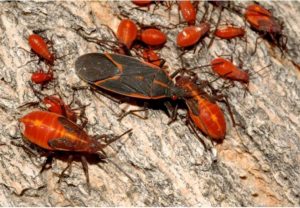The Boxelder Bug
Friend or Foe?
By Helen C. Hollingsworth, Fairfax Master Gardener
 The boxelder bug (Boisea trivittata) is a true bug with piercing-sucking mouth parts that cause minor plant damage as they consume sap from leaves, stems and seeds. Adults are one-half inch long by one-third inch wide. Their bodies are black, edged and veined with red-orange. Nymphs are red. They are a pest of the boxelder, a fast-growing native tree usually found in river bottoms and wet soils. Because of its exceptional adaptability, boxelders have expanded their range into disturbed sites and urban areas. However, the bugs can be seen even with no boxelder trees nearby, since they also feed on other trees in the maple family, particularly silver maple and golden raintree. Additionally, since these bugs can fly up to 2 miles from their host plants, a swarm can occur without any of these trees nearby.
The boxelder bug (Boisea trivittata) is a true bug with piercing-sucking mouth parts that cause minor plant damage as they consume sap from leaves, stems and seeds. Adults are one-half inch long by one-third inch wide. Their bodies are black, edged and veined with red-orange. Nymphs are red. They are a pest of the boxelder, a fast-growing native tree usually found in river bottoms and wet soils. Because of its exceptional adaptability, boxelders have expanded their range into disturbed sites and urban areas. However, the bugs can be seen even with no boxelder trees nearby, since they also feed on other trees in the maple family, particularly silver maple and golden raintree. Additionally, since these bugs can fly up to 2 miles from their host plants, a swarm can occur without any of these trees nearby.
The boxelder bug breeds on female boxelder trees, laying red eggs in crevices in the bark and on the samaras (seeds). There are usually two generations per season, one in spring and one in early autumn.

Boxelder bugs – adults and nymphs
Boxelder bugs become problematic in the fall, when they begin searching for places to over-winter. Frequently the warmer southern or western exposure of a nearby house is found to be suitable, and hundreds will swarm there, seeking gaps in siding, under eaves and in tiny cracks leading inside. Even though they don’t harm the exterior (other than stains from fecal matter) or interior of the building, homeowners generally don’t want bugs crawling on their houses and entering their homes. In the spring, new swarming occurs as they begin seeking their breeding grounds. Some get stuck in the house while trying to find a way out, causing a second wave for the homeowner to deal with.
There are several steps a homeowner can take to help alleviate the problem. The first is to remove all host trees, which they may find unacceptable. Removing them won’t eliminate the problem if a neighbor has a host tree, but it should decrease the population on the homeowner’s property.
Improving sanitation and maximizing exclusion is important. Eliminating hiding places by moving objects and mulch away from the foundation helps, as does sealing up access points. A wet/dry vacuum containing soapy water will suck up and kill many bugs.
Indoors, vacuuming the invaders is the best solution. It’s best to avoid crushing the bugs as they can leave a red stain and an odor. To control the outdoor population, the homeowner can apply a preventative perimeter spray in mid-to-late August. The Pest Management Guide lists treatments for the boxelder bug under Nuisance Insects of the House and Yard. Note that pesticide cannot be applied along concrete surfaces where there is risk of storm run-off or when pollinators are present.
Is the boxelder bug a friend or a foe? Though harmless, those who have to deal with these bugs every year most likely consider them foes.
References
• Boxelder Bug, Section 6-9, table 6.3, 2018 Virginia Pest Management Guide
• Boxelder Bugs ENTFACT-444, Lee Townsend, Extension Entomologist, University of Kentucky College
of Agriculture
• Boxelder Bugs and Red-Shouldered Bugs, Karen Vail, Frank Hale, and William Klingeman, University of
Tennessee Agricultural Extension Service
• Boxelder Bug, Eric Day, Department of Entomology, Virginia Tech
• Insects, Hannah Burrack, Matt Bertone, North Carolina Extension Gardener Handbook
… updated 2022